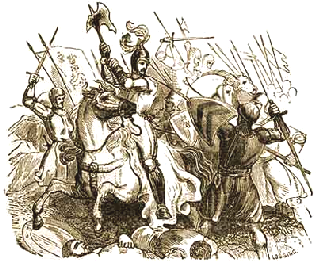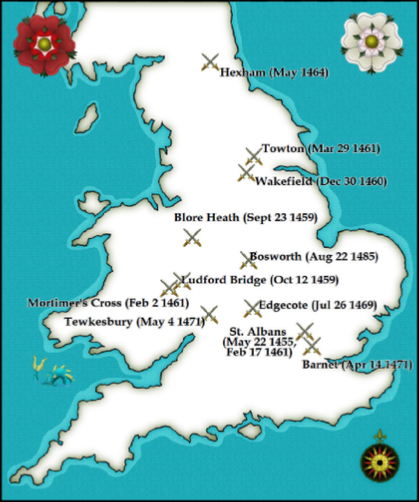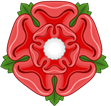


THE WARS OF THE ROSES 1455 -
Including:
Margaret
of Anjou

xxxxxThe Wars of the Roses was a series of armed clashes between the rival houses of Lancaster, led by the king and his wife Margaret of Anjou, and of York, led by Richard, Duke of York, and his son Edward. Brought about by the social, economic and political unrest throughout the country, it lasted some 30 years. At first, the struggle went in favour of the Yorkists. They won the Battle of St. Albans in 1455 -
aaaaaThe Wars of the Roses  was a series of armed clashes between the rival houses of Lancaster, led by the king and his wife Margaret of Anjou, and the Yorkists, led initially by Richard, Duke of York. It lasted, off and on, for some thirty years and culminated in the defeat of the Yorkists at the Battle of Bosworth Field in 1485 (R3). This Lancastrian victory marked the beginning of the Tudor period under Henry VII.
was a series of armed clashes between the rival houses of Lancaster, led by the king and his wife Margaret of Anjou, and the Yorkists, led initially by Richard, Duke of York. It lasted, off and on, for some thirty years and culminated in the defeat of the Yorkists at the Battle of Bosworth Field in 1485 (R3). This Lancastrian victory marked the beginning of the Tudor period under Henry VII.
aaaaaThe first phase of this messy conflict began in 1455 and ended six years later when Henry was defeated and forced off his thrown by Edward, the son of Richard of York. That a revolt against the crown should have broken out in 1455 is hardly surprising. The country was in a very poor state. Henry was constantly suffering from bouts of insanity and could give no firm lead; the war in France had been lost; and there was a great deal of social and political unrest throughout the country, exemplified in the south-

aaaaaLike the king himself, Richard, Duke of York, could lay claim to the throne through Edward III. -
aaaaaAll seemed over, but Edward, the son of the Duke of York, now took up his father’s mantle. He marched to London and in 1461 proclaimed himself king, an appointment clearly confirmed in March of that year when he won the decisive and bloody Battle of Towton against the Lancastrians and was crowned Edward IV. Henry, together with his wife and son, fled to Scotland but, as we shall see, he made a dramatic comeback in 1470 (E4), brief though it proved to be, and the struggle was resumed in 1471 (E4).
Incidentally, the  term “Wars of the Roses”,
term “Wars of the Roses”,  so named because it is alleged that the Lancastrians had the red rose as their emblem and the Yorkists sported a white one, was not used at the time of the conflict. Indeed, it seems that the name did not emerge until the nineteenth century when the English writer Sir Walter Scott used it in one of his novels.
so named because it is alleged that the Lancastrians had the red rose as their emblem and the Yorkists sported a white one, was not used at the time of the conflict. Indeed, it seems that the name did not emerge until the nineteenth century when the English writer Sir Walter Scott used it in one of his novels.



Acknowledgements
Battle scene: date and artist unknown. Map: by courtesy of TimeRef.com.
H6-